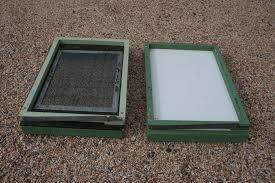Varroa has not yet established in Australia. In the advent that it does establish, beekeepers need to be aware of the available control methods. Chemical treatments have several drawbacks. Miticide residues have been reported in honey and bees wax, mites can become immune to the miticides, and their use prevents bees from being selected for natural resistance mechanisms.
Screened bottom boards are used for the management and quantification of Varroa mites overseas. Varroa that are groomed off adult bees will fall through the screen and become trapped on a sticky mat or in oil or petroleum jelly placed in a tray under the screen. Screened bottom boards are not a stand-alone treatment method for Varroa.

Screened bottom boards are used overseas to reduce the number of Varroa mites.
Source: Doug Somerville
Uptake of screened bottom boards is hindered by the perception that hive productivity will be reduced due to the bees having trouble maintaining temperature or humidity. An AgriFutures Australia study headed by Doug Somerville compared weight gain in 30 hives with conventional bottom boards with that in 30 hives with screened bottom boards, over a period of 14 months. The screened bottom boards in this study had 3mm apertures.
There was little difference in internal hive minimum and maximum temperature between the two treatments (<0.5oC). Relative humidity may be a few percent higher in colonies with screened bottom boards. These results are similar to a study conducted in Spain.
The hives with screened bottom boards gained 15% more weight than those with conventional bottom boards, though there was no statistical difference between the treatments. Another Australian study also found that honey production was not affected.
The use of screened bottom boards will also enable ventilation when moving hives or shutting them up during crop spraying.
If you would like to test out screened bottom boards in your operations start with buying 10. Consider requeening these 10 colonies and another 10 colonies with sister queens. Monitor the colonies over the season to see how the colonies perform.
Acknowledgements:
- Somerville & D. Collins (2014) Screened bottom boards. Rural Industries Research & Development Corporation Publication 14/061
- Video: Research results into the usefulness of screened bottom boards, Doug Somerville, NSW Department of Primary Industries
- This article was written by Nadine Chapman and features Doug Somerville. It was reviewed by John Roberts.

